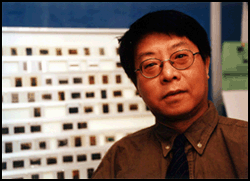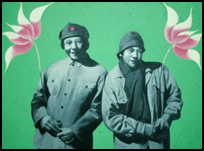Minglu Gao is an artist, art historian, curator and author who was born and bred in the political and cultural tumult of late 20th-century China.
Political circumstances uprooted him from a secure urban childhood and sent him off to spend his teen-aged years herding cattle in Mongolia. They later propelled him into the explosive Chinese art movement of the 1980s, of which he remains the principle documentarian.
| |
 |
| |
Political circumstances propelled art historian Minglu Gao into the explosive Chinese art movement of the 1980s. |
| |
Photo: Stephanie Hamberger |
Today a noted curator and assistant professor of art history at UB, Gao is a man of exceptional intellect and training with unusual insight into his countrymen's ancient artistic traditions. He has witnessed, as well, their increasing use of Western conceptual forms as they have tried to come to grips with their "erased" historical past in an environment of tremendous economic and social change, and cultural conflict.
He has curated what remains the most notable exhibitions of this work in China and in the United States and is about to publish two major books that assess the theoretical underpinnings of Chinese traditional art and the important Chinese avant-garde movement of the past 20 years. His story of personal and professional struggle, survival and success, cannot be separated from his nation's recent history and, in fact, illuminates the many ways in which that history has informed the lives of the Chinese people.
Gao's academic specialization in the ancient, traditional Chinese art forms was possible only after the end of the Cultural Revolution (1966-76). This was Mao's last attempt to force a spiritual and structural transformation of Chinese society by destroying any and all artifacts of pre-revolutionary Chinese culture. It was a period marked by social upheaval, personal vendettas, violence, massive youth movements and extreme ideological pressure, when deeply rooted cultural assumptions and ancient visual traditions were under continual attack.
When the Cultural Revolution began, Gao was a child living with his artistic and liberal-minded family in the large industrial city of Tianjin, near Beijing. He still finds it difficult to recount the traumatic events that followed. His family was targeted by the government as dissident, his father arrested and, over his mother's desperate and strenuous pleas, 12-year-old Gao was "sent-down" to the provinces like millions of other educated Chinese youth, where he was expected to learn the virtues of living like a peasant.
He spent six isolated, lonely and often brutal years as a cattleherder on the Mongolian plains-"an extraordinary experience that changed my life," says Gao, whose son, Roy, not coincidentally, is named for American cowboy-hero Roy Rogers.
The Mongolian philosophy, a mixture of traditional, nature-centered shamanism and Tibetan Buddhism, stresses acceptance of the natural cycle and natural processes. This was most helpful to him, says Gao, in coping with the extreme loneliness of his world and the often life-threatening weather conditions in which he worked.
Deprived of a normal education, Gao taught himself traditional academic subjects like math, chemistry and literature using textbooks sent by his family.
When the Cultural Revolution ended, the 19-year-old Gao, who had always had a gift for artistic expression, hoped to attend college in Beijing. His family was still "suspect," however, so he was not allowed to attend his university of choice, Beijing's prestigious Chinese Academy of Arts.
Several years later, after graduating from another college and scoring unusually high grades on the national entrance exam, he was accepted into the academy's exceptionally competitive and difficult program in art history.
In the meantime, Deng Xaio Ping became the new leader of the People's Republic. He brought to his office the urge to open China's doors to the outside world and a well-grounded fear of youth movements. Both tendencies would influence Gao.
As the Cultural Revolution wound down, China experienced a period of rapid modernization, along with economic reforms and "opening up" policies initiated by Deng. Like many of his generation, Gao was exhilarated by the increased freedom of expression in China, which allowed the introduction of Western art and theory in the early 1980s.
Upon receipt of his master's degree in 1981, Gao became an editor of Meishu, China's influential official organ of the fine arts, and soon was involved with new artists known collectively as the "'85 New Wave Movement." These artists expressed utopian goals and humanist values, and many worked under the precepts of anti-subjectivity and anti-authorship. Inspired by Dadaist conceptualism and Chan Buddhism, Gao says the movement attempted to synthesize Western art and theory, and Chinese tradition, which adherents hoped would help bring about changes in Chinese society.
| |
 |
| |
Li Shan’s “Mao and the Artist,” 1994, Acrylic on Canvas, 150x180 cm. Collection of Hanart, Hong Kong |
During this extraordinary period of social and political upheaval, Gao emerged as a spokesman for Chinese artists documenting this astonishing change.
Although Deng's "open door" was still open, Gao recognized the coming crackdown on "too-free" expression. Nevertheless, despite bureaucratic roadblocks, he spearheaded a complex, years-long collaborative effort to mount "China/Avant-garde," the seminal exhibition of contemporary mainland Chinese art, in February 1989.
A political show with close links to China's pro-democracy movement, it was closed down within hours of its opening.
"No U-Turn (the exhibition's symbol), originally used to emphasize the idea that Chinese art must move forward, became a banner for the pro-democracy movement as a whole," says Gao. The political repression that followed the confrontation in Tiananmen Square sent many artists and intellectuals, including Gao, into exile.
Since moving to the United States in 1991, he has worked to ensure that the voices of contemporary Chinese artists are heard above the din of radical worldwide social and economic change that marked the end of the 20th century.
In 1998, while still a doctoral student at Harvard University, he curated, "Inside/Out: New Chinese Art," the first major international exhibition to explore the impact of these changes on artists in the People's Republic of China, Hong Kong, Taiwan and those of the 1980s Chinese diaspora.
The exhibit, which received much critical praise for its documentation of the creative explosion in Chinese art of the last decade, has traveled to Australia and Hong Kong.
In keeping with his work in this field, Gao has two books in preparation: "The Century's Utopia," a comparison of artistic avant gardes of 20th-century China and the west, and "The Myth of 20th Century Art," a more theoretical work on the study of Chinese art and how Chinese and Western critics have assessed this work.


